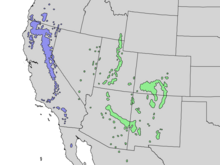White fir
|
Abies concolor White fir |
|
|---|---|
 |
|
| Sierra Nevada white fir in Yosemite National Park |
|
| Scientific classification | |
| Kingdom: | Plantae |
| Division: | Pinophyta |
| Class: | Pinopsida |
| Order: | Pinales |
| Family: | Pinaceae |
| Genus: | Abies |
| Species: | A. concolor |
| Binomial name | |
|
Abies concolor (Gordon) Lindley ex Hildebrand |
|
 |
|
| Natural range of var. concolor in green and var. lowiana in blue | |
| Synonyms | |
|
|
Abies concolor, commonly known as the white fir or Colorado white-fir, is a fir native to the mountains of western North America, occurring at elevations of 900–3,400 m (3,000–11,200 ft). It is a medium to large evergreen coniferous tree growing to 25–60 m (80–195 ft) tall and with a trunk diameter of up to 2 m (6.6 ft). It is popular as an ornamental landscaping tree and as a Christmas tree. It is sometimes called concolor fir.
The leaves are needle-like, flattened, 2.5–6 cm (1–2 3⁄8 in) long and 2 mm (3⁄32 in) wide by 0.5–1 mm (1⁄64–3⁄64 in) thick, green to glaucous blue-green above, and with two glaucous blue-white bands of stomatal bloom below, and slightly notched to bluntly pointed at the tip. The leaf arrangement is spiral on the shoot, but with each leaf variably twisted at the base so they all lie in either two more-or-less flat ranks on either side of the shoot, or upswept across the top of the shoot but not below the shoot.
The cones are 6–12 cm (2 1⁄4–4 3⁄4 in) long and 4–4.5 cm (1 5⁄8–1 3⁄4 in) broad, green or purple ripening pale brown, with about 100–150 scales; the scale bracts are short, and hidden in the closed cone. The winged seeds are released when the cones disintegrate at maturity about 6 months after pollination.
As treated here, there are two subspecies; these are also variously treated at either the lower rank of variety by some authors, or as distinct species by others:
...
Wikipedia

